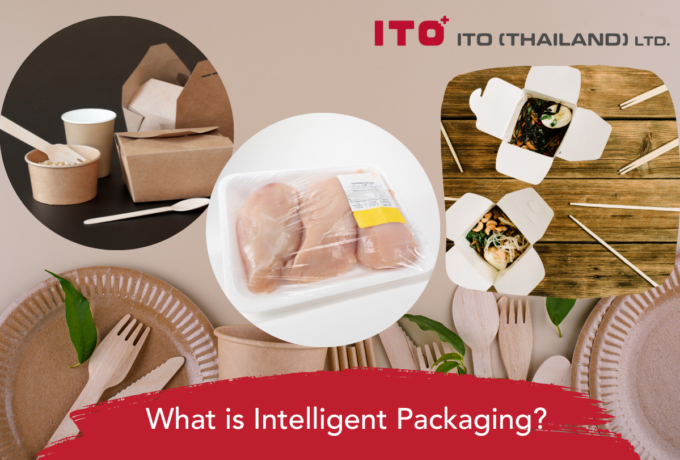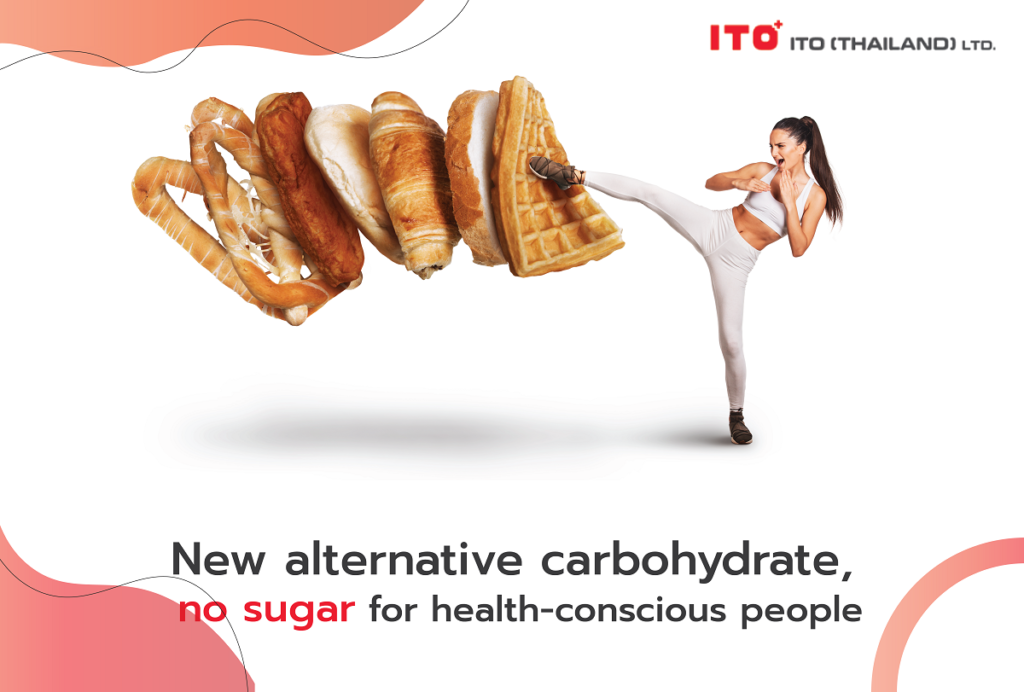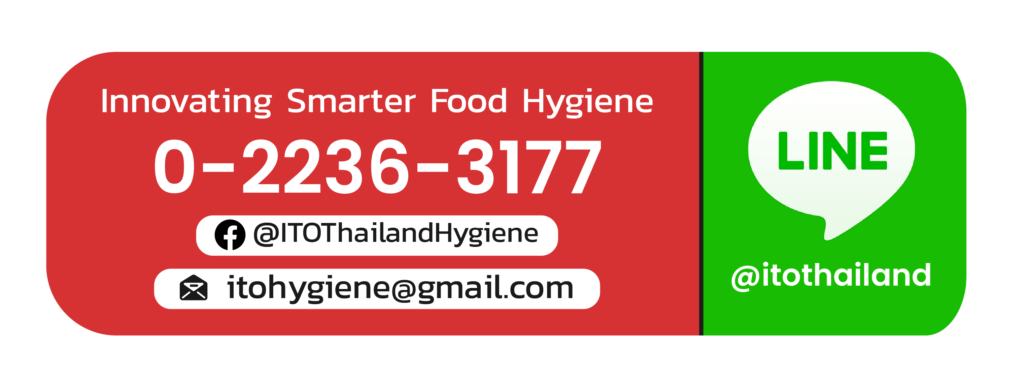ITO Thailand Hygiene Blog
Alternative foods: Carbohydrate
Alternative Carbohydrate Products
The trend of interest in alternative products for the original carbohydrate replacement occurs for many reasons such as the problem of excise taxes on sweetness causing entrepreneurs to use sweeteners instead of sugar to reduce the amount of sugar in the product, but the same degree of sweetness is maintained. The reasons also include diabetics, healthy trends, low carbohydrate diets or ketogenic diets, or foods with a reduced glycemic index. Or even for protein allergies that prevent certain consumers from eating certain foods, such as wheat flour, which is the main ingredient of bakery products, replacement products have been developed that do not contain wheat flour or gluten-free proteins, which still resemble normal bakery products.
As you can see, these replacement products must have key characteristics that consumers accept: color, smell, taste, and texture, whether they are close to the original products or as new features.
Carbohydrate replacement products can be divided according to the function: substitute sweet feeling, replace the feeling of fullness, or act as a bulking agent, but it is intended to reduce the energy generated from carbohydrates or change the type of carbohydrates/ food structure for health effects.
In the case of sweetener substitutes, alternative sweeteners are used to replace sugar or sucrose, such as sugar alcohols (sorbitol, xylitol, maltitol), saccharin, cyclamate, aspartame, sucralose, and stevia extract, etc. These sweeteners are usually 180-600 (1) times sweeter than granulated sugar (except for sugar alcohols that are less sweet than sugar). This makes it possible to use them in small quantities and get the sweetness equivalent of sugar without low energy, or some of them do not provide energy to the body.
However, these sweeteners cannot replace sugar for 100% due to several limitations: the sweetness of each sweetener differs in characteristics: Some are sweet in the throat, while others leave a bitter aftertaste, which consumers can recognize. In addition, some sweeteners have restrictions for patients, such as aspartame, which is harmful to patients with the genetic disease of phenylketonuria.
Sweeteners cannot replace the physical and chemical properties of sugar, such as caramelization reactions that are the source of specific colors and flavors, increasing viscosity for the products, microbial protection, melting points, and crystallization that differs from granulated sugar, etc. Some sweeteners do not tolerate extreme heat. This makes it not possible to use in heated products such as bakery or fried food products. Some are low in acidity, making them unsuitable for use in citrussy drinks. In addition, some sweeteners also have side effects when ingested in large quantities, such as sugar alcohols, which have a digestive effect and can cause bloating or abdominal discomfort. (2) Therefore, the Ministry of Public Health has determined the maximum amount of sweeteners in products following the Ministry of Public Health Announcement (No. 418) B.E. 2563 (2020).
Carbohydrate substitution in the starch group is usually determined by the glycemic index, which is the speed at which carbohydrate or starch is digested into sugar and absorbed into the bloodstream, depending on the speed of accession of enzymes, digestible sugar structure, characteristics of starch granular structure that may hinder digestion, characteristics of carbohydrate molecular structures, and other substances in the system that may disrupt the interaction of enzymes. If the body digests carbohydrates and absorbs them into sugar quickly, the food would have a high glycemic index, which results in an acute spike in blood sugar levels and fluctuations. This causes the body to secrete insulin hormones to deal with blood sugar, which is a problem among diabetics with the abnormal secretion of insulin. This makes dealing with blood sugar less effective. Diabetics, therefore, must control diets with a high glycemic index. In addition, after blood sugar rises and falls quickly, the body will quickly feel hungry as well. Therefore, starch substitute products with the characteristics of modifying the structure of carbohydrates to be harder to digest (e.g., crystallizing starch in a stable form or creating a complex structure with fat), or adding substances that hinder the digestion of enzymes (such as dietary fiber), or changing the type of starch into a structured starch that is difficult for the body to digest, help to keep the body feeling full for a long period and gradually digest starch into sugar absorbed into the bloodstream without severe, acute changes. This is another technique to transform starch products to have a lower energy index. Consumers can stay fuller for longer and have a healthy effect.
In addition to changing the type or modifying starch, the use of low-carb alternative products is becoming popular, especially eating keto diets by substituting starch to be full. In addition to eating protein and fat, vegetables with lower carbohydrate content and glycemic index are used, such as cauliflowers and broccolis to replace the same amount of white rice. Eating crispy vegetable leaves instead of crunchy snacks, etc. This creates a lot of new products.
Some carbohydrates, such as wheat flour, barley, rye contain gluten protein, which cannot be consumed by those who are allergic to them. And among ordinary consumers, some groups believe that gluten adversely affects health and the immune system, so they prefer gluten-free foods such as rice flour as substitutes in bakery products. But the challenge is that gluten protein is the main structure of bakery products and gives bakeries like cakes or bread a porous structure and allows air to permeate, whereas rice flour gives you a firm pastry style (for example, a Thai banana snack). Therefore, in the development of gluten-free bakery products from rice flour, food additives must be developed so that the structure of gluten-free flour is closer to that of wheat flour.
There are a lot of ways to develop carbohydrate replacement food products because consumers have high demand and have many ideas with technology that are interesting in product development. Ito Thailand hopes to be part of inspiring ideas for new products in the Thai food industry to be developed sustainably.
References
1กนกกาญจน์ ปานจันทร์. 2559. สารให้ความหวานแทนน้ำตาล. สรรสาระ วารสารกรมวิทยาศาสตร์บริการ. http://lib3.dss.go.th/fulltext/dss_j/2559_64_202_p27-28.pdf วันที่เข้าถึง: 28 ตค 2021
2Grembecka, M. (2015). Sugar alcohols—their role in the modern world of sweeteners: a review. European Food Research and Technology, 241(1), 1-14.
Related Post
-

Biodegradable Packaging
As straightforward as its name, it means any packaging that will naturally fall apart and decompose. In recent years, biodegradable packaging has been included as one of the sustainable development goals for several organisations. A similar issue, bioplastics, an alternative to sustainable living, was discussed in a previous blog. However, there are some differences between them. For example, bioplastics are made from raw materials sourced from renewable and natural sources and could or could not be biodegradable. In contrast, biodegradable plastic can naturally degrade through living organisms no matter the source material it originates from. The development history of biodegradable packaging, frequently used materials, the pros and cons of biodegradable packaging, and its future trends will be discussed in this blog.
-

Precision Agriculture
Precision agriculture has revolutionised how we approach crop management by optimising the inputs to meet specific requirements. Even though it is not a new system, recent technologies have made it possible to apply it in practical productions. In this blog, we will discuss the definition of precision agriculture, its pros and cons, and future trends.
-

Vertical Farming
Agriculture has utilised nearly all the available land, causing growing difficulty in finding land on the earth’s surface. With limited resources, meeting the world’s food demands will require more innovative and dependable methods of producing safe food, and the answer lies in vertical farming.
-

Intelligent Packaging
Without packaging, food products would last for only a short period of time, impossible for logistics management, difficulties in the supply chain system, quick quality deterioration, and prone to contamination to risky foodborne pathogens. In reality, there are many more functions that packaging is contributing to food products, as well as many types of smart packaging. Intelligent packaging is considered to be a part of smart packaging, so in this blog, we will discuss the contribution of intelligent packaging to food products.
-

Robots & automation in the food industry
Entering a new era in the food industry with robotics and automation in the food industry
-

Nanotechnology in the Food Industry
Nanotechnology has been brought to our attention for the last decades, and it has provided various beneficial applications to the food industry. Unlike other technology, nanotechnology has broadened the knowledge in the food industry to another level in a nanoscale dimension. It involves almost every aspect of the food industry, including food packaging, food processing, as well as functional food development and enhancement of food safety. In this blog, we will discuss how nanotechnology is used in food packaging and food products, and the most important part, its safety issues.










